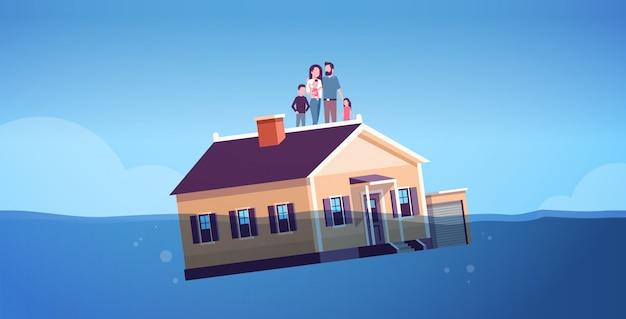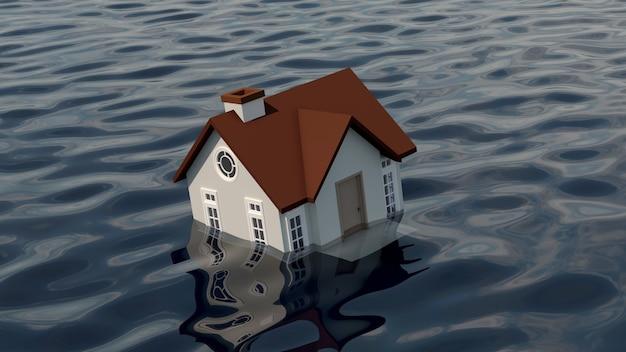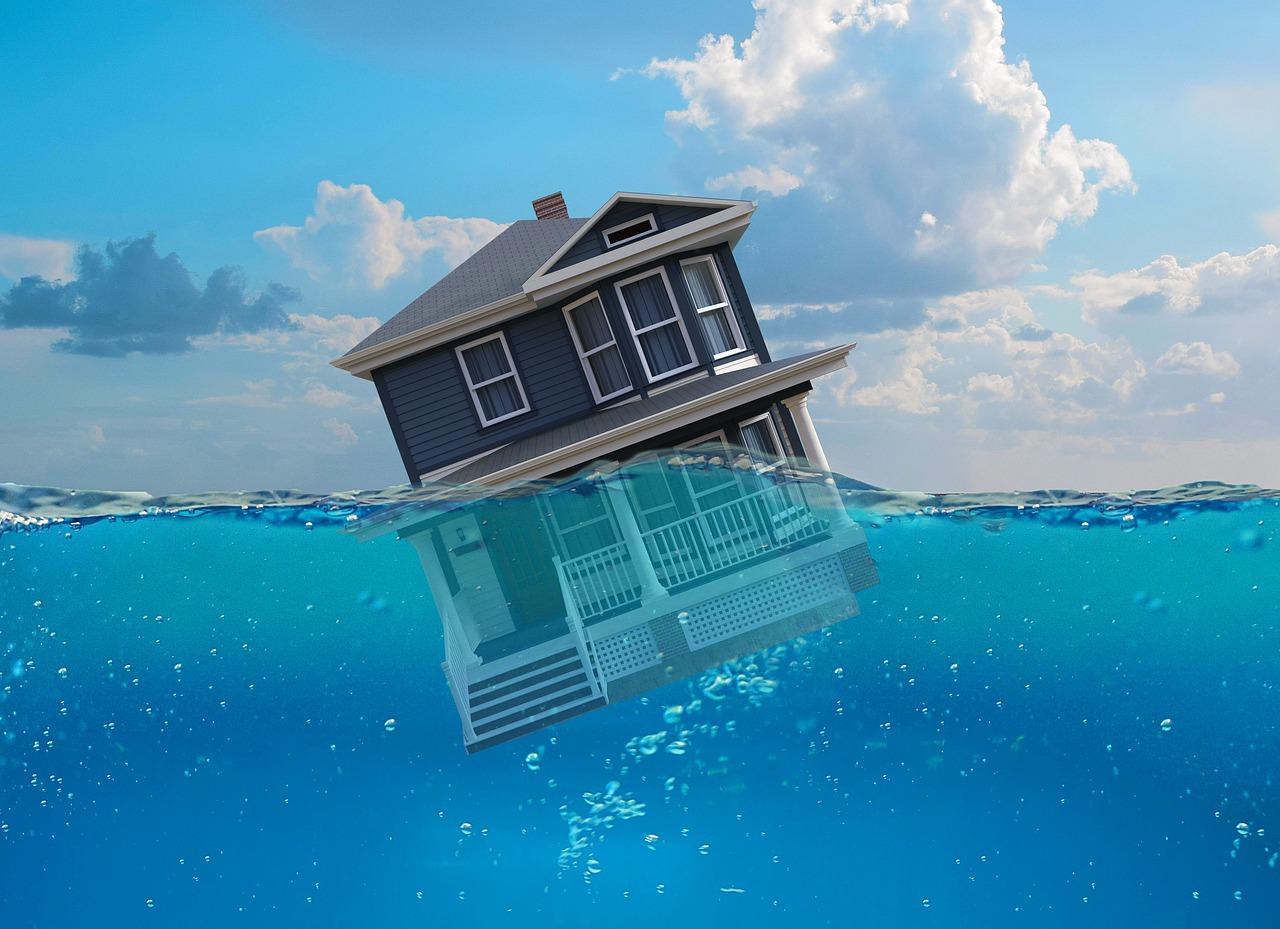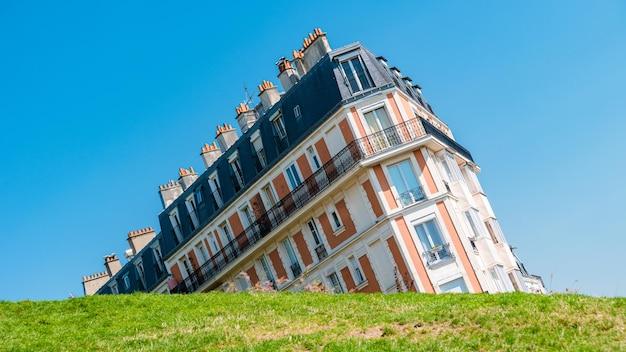Are you worried that your house might be sinking? Foundation issues can cause significant damage to your home and your wallet. In this blog post, we will discuss the telltale signs of a sinking house, the cost of foundation repairs, whether insurance covers such issues, and what happens when your house starts sinking. By the end, you’ll have a better understanding of what to look out for and what steps to take if you suspect your house is sinking. Let’s dive in!
How to Tell If Your House Is Sinking
Is your house feeling a little low these days? Well, before you blame it on the gloomy weather or your laziness to clean, let’s consider if it could actually be sinking. Don’t worry, we’ve got your back (and your foundation)! Here are a few handy signs to help you figure out if your dear old home is sinking like a sad deflated balloon:
Cracked-Up Walls and Floors
We’re not talking about intentionally trendy distressed walls here, but rather about those unexpected fractures and crevices that seem to have taken a life of their own. If your walls or floors are resembling a cracked mosaic artwork, it might be time to question the structural integrity of your house. Embrace the quirks and charms of your home, but don’t let it crumble!
Wonky Doors and Windows
If your doors and windows are no longer obedient and seem to be playing a rebellious hide-and-seek game, it’s definitely something to take note of. Have you noticed that doors no longer fit their frames snugly, or that windows refuse to close without a struggle? Your house may be telling you it’s time to call in the professionals to see if it’s suffering from a sinking syndrome.
Other Strange Happenings
In addition to the more obvious signs, there are a few other peculiar occurrences that might indicate your house has decided to take a nosedive. Keep an eye out for these unusual happenings:
Sloping Floors
Do your feet often feel like they’re on a roller coaster as you navigate your home? If you notice that your floors are gradually transforming into a mini amusement park ride with unexpected drops and slopes, it’s probably not a part of the grand design. Don’t let gravity dictate your everyday movements.
Leaning Chimney
Picture this: you’re cozied up by the fireplace, sipping hot cocoa and enjoying a quiet evening. Suddenly, you notice that the chimney has taken on a peculiar angle, as if it decided to take a nap mid-brick. While we all appreciate a good lean, your chimney should have better manners. Time to investigate if your house is buckling under pressure.
Stuck Doors and Windows
Sometimes, your doors and windows may not rebel outright but give subtle hints of distress. If they’re becoming unusually sticky, making you doubt your arm strength, it might be a red flag. Your house could be whispering for help, desperate to break free from its sinking fate.
Don’t Panic, Call a Pro
Remember, we may be able to DIY our way through minor home repairs, but when it comes to sinking houses, it’s best to call in the experts. Take a deep breath and pick up the phone; seek out a qualified professional who can assess the situation and offer solutions to save your beloved abode. After all, a sinking ship may be adventurous on the high seas, but a sinking house? Not so much!
Sinking Foundation Repair Cost
You’ve just realized your house might be sinking, and now you’re wondering how much this whole repair thing is going to set you back. Well, let’s break it down together and see what kind of dent it might make in your bank account.
Assessing the Damage
First things first, before diving into the cost, you’ll need to have an expert come in and assess the situation. This initial inspection is crucial to determine the severity of the problem and figure out the best course of action. It’s like going to the doctor for a diagnosis, except in this case, the doctor is a foundation specialist. These inspections typically range anywhere from $300 to $800, depending on the size of your home and the extent of the damage.
Patching Up the Foundation
Once you have a clear understanding of what needs to be done, it’s time to roll up your sleeves and get to work. Well, actually, let the professionals handle it. Remember, we’re talking about your home’s foundation here, not a DIY Pinterest project. The cost of foundation repair can vary significantly, depending on several factors, such as the type of foundation, the extent of the damage, and the region you’re in. On average, you’re looking at anywhere between $5,000 to $15,000 for the repairs. Yeah, it’s not exactly pocket change, but hey, you can’t put a price on having a stable and safe home, right?
Other Associated Costs
Now, brace yourself (pun intended) because we’re not quite done yet. There are a few additional costs you might want to consider. For starters, if your foundation issues have caused any cosmetic damage to your home, like cracks in the walls or uneven floors, you’ll need to budget for repairs on those as well. And don’t forget about any belongings that may need to be temporarily moved or stored during the repair process. Oh, and let’s not overlook the potential cost of renting a temporary place to crash if the repairs take longer than expected.
Prevention is Key
While we’re on the topic of cost, it’s worth mentioning that investing in preventive measures could potentially save you a boatload of money in the long run. Regularly checking for signs of foundation issues, keeping the soil around your home properly watered, and ensuring proper drainage can help mitigate the risk of foundation problems. So, yeah, maybe a little maintenance now can save you from shelling out big bucks down the line. Just saying!
Conclusion
So, there you have it. Repairing a sinking foundation is no walk in the park, but it’s a necessary evil when it comes to taking care of your home. While the cost can be hefty, remember that ensuring your home’s stability and your family’s safety is priceless. So, if you suspect your house is sinking, don’t ignore it. Get an expert opinion, assess the damage, and tackle the repairs head-on. And hey, if things get a little tough along the way, just remind yourself that you’re building the foundation for a bright future.
Signs that Your House is in Danger of Collapse
One of the scariest signs that your beloved abode might be on the brink of total collapse is an unstable foundation. If your house resembles a wobbly Jenga tower, it’s probably time to panic (or at least call in the professionals). Keep an eye out for walls developing alarming cracks, doors refusing to close properly, or floors that mysteriously slope in unexpected directions. It’s like living in a real-life funhouse, minus the fun.
Sinkholes: When Your House Plays Hide and Seek
Oh no, did your house just vanish into thin air? If so, you may have a sinkhole on your hands. Sinkholes are like mysterious portals to another dimension, but with significantly less excitement and more property damage. If your front yard suddenly resembles a scene from an action movie, complete with collapsing earth and disappearing vehicles, it’s time to start considering alternative accommodations – preferably above ground.
Creaking and Groaning: Not Just for Halloween
Do you hear spooky sounds coming from your walls? No, it’s not haunted, but rather a sign that your house might be approaching its expiration date. Creaking, groaning, and other unsettling noises can indicate that your home’s structural integrity is compromised. While it may seem like your house is serenading you with a creepy symphony, it’s actually begging for immediate attention and repairs. Consider it a musical cry for help.
Leaning Towers: More Than Just a Pisa Problem
Leaning towers might be charming tourist attractions in Italy, but when your own home starts resembling the famous Tower of Pisa, it’s no cause for celebration. If your once-straight walls are suddenly sporting a trendy diagonal slant, it’s time to say arrivederci to your current living situation. Don’t wait for your house to become a major tourist hot spot – contact the experts and bid farewell to your leaning tower of trouble.
Crumbling Facade: The Beauty Fades Away
Be warned: If your house’s exterior starts to resemble a dilapidated castle from a fairytale gone wrong, it’s not just an aesthetic issue. Cracks, crumbling bricks, and unsightly decay can signal serious structural problems that won’t magically disappear with a fresh coat of paint. Before you know it, your charming home could turn into the setting for the next horror film. Keep those prince charming fantasies in check and tackle those facade flaws head-on.
When it comes to the signs of an impending house collapse, it’s better to be safe than sorry. Don’t ignore the warning signs of an unstable foundation, sinkholes making a surprise appearance, unsettling creaks and groans, leaning towers, or crumbling facades. Remember, it’s your home – not a game of Jenga or a crumbling fairytale. Keep an eye out for these signs, take action promptly, and protect your castle from turning into a real estate disaster.
House Sinking Covered by Insurance
At some point, we’ve all experienced that sinking feeling, like when you realize you left your phone at home and you’re halfway to work. But what about when it’s your house that’s sinking? Is it covered by insurance? Let’s dive into the murky depths of this important topic.
The ups and downs of house sinking
Picture this: you’re peacefully enjoying your favorite TV show when you feel a sudden jolt. “Must be an earthquake,” you think to yourself. But what if it’s not an earthquake? What if it’s your house slowly sinking into the ground like a deflating soufflé? It sounds like a nightmare, but it can happen.
The sinking feeling of insurance coverage
Now, you might be wondering, “Will my insurance cover a sinking house?” Well, my friend, it depends on a couple of factors. First, you need to determine the cause of the sinking. If it’s due to natural disasters like earthquakes or floods, then you’re in luck. Most insurance policies cover damages caused by these events.
When it’s more than just nature’s fault
But what if the sinking is not caused by natural disasters? What if it’s a result of poor construction, unstable soil, or the fact that your house was built on a hidden underground river (because who doesn’t want a secret river running through their basement)?
Insurance to the rescue (or not)
Unfortunately, in these cases, insurance coverage becomes a bit trickier. Some insurance policies may have exclusions for damages caused by poor construction or soil instability. You might find yourself sinking deeper into despair as you realize that your insurance company won’t be coming to your rescue.
Let’s talk about endorsements
But don’t lose all hope just yet! Some insurance companies offer endorsements or additional coverage options specifically for house sinking. These endorsements can provide much-needed protection for your sinking castle.
Make friends with your insurance agent
Remember, every insurance policy is different, just like every sinking house is unique. The best way to find out if your insurance will cover a sinking house is to have a friendly chat with your insurance agent. They can explain the ins and outs (or should we say the ups and downs?) of your policy and help you determine the extent of your coverage.
The final verdict
In conclusion (but not sinking, hopefully), whether or not your sinking house is covered by insurance depends on various factors. Natural disasters might be covered, but the causes of sinking related to construction or soil instability could present challenges. Don’t forget to check for endorsements or additional coverage options. And remember, when in doubt, discuss it with your insurance agent—they’re the superheroes of the insurance world!
Stay afloat, my friends!
So keep an eye on those cracks in the walls and those doors that won’t close properly. If you suspect your house might be sinking, take action and evaluate your insurance coverage. Your sinking ship might not be completely doomed. Stay afloat, my friends, and may your houses always rise above the troubles that threaten to sink them!
What Happens if Your House is Sinking
So, you’ve just realized that your beloved house might be sinking. Don’t panic just yet! Let’s explore what could be going on below your feet and find out what might happen if your house is, indeed, taking a dip.
Signs to Look Out For
The first indication that your house might be sinking is often the appearance of cracks in the walls or ceilings. These cracks can be subtle at first, but over time, they can grow larger and more pronounced. So, if you suddenly find yourself living in a house that resembles a road map, it’s time to investigate further.
Another telltale sign is doors and windows that struggle to close properly. If you notice that your once-smooth entrances have become temperamental beasts, refusing to shut without a real fight, your house might be trying to tell you something.
Becoming the Hunchback of Neighborly Lane
One amusing consequence of a sinking house is the shift in the floor. Imagine suddenly realizing that you’re constantly walking uphill in your supposedly flat house! Forget about getting a workout at the gym—you’ll be getting your cardio just walking from room to room.
And don’t even try to set a ball rolling on the floor. It will become your new frenemy, as it stubbornly rolls uphill… or downhill. It’s like living in your very own twisted version of The Wizard of Oz.
The Living Room Waterslide
If your house is sinking, you might also experience the joys of indoor water features. Forget about adding a fancy fountain; your living room might turn into a mini swimming pool—just without the fun of floating around on a sunny day. Picture yourself attempting to watch your favorite TV show while wading through ankle-deep water. Talk about an immersive viewing experience!
Furniture Rebellion
Your beloved furniture and appliances might start to rebel against their sudden new tilted reality. Chairs may slide across the floor, desperate to reach an equilibrium they will never find. Bookshelves might resemble an abstract art installation, as they lean precariously against the wall. And don’t even get me started on the poor fridge—opening it will become a thrilling game of “catch the flying milk carton.”
Head in the Clouds
Living in a sinking house can have an unexpected side effect: a height complex. As your house sinks, so does your self-esteem—in comparison to your neighbors, at least. You might go from having a view to staring at everyone’s roof shingles. It’s like being cast as the lead role in a real estate version of “Honey, I Shrunk the Kids.”
And let’s not even mention the awkwardness at social gatherings when your friends realize they have to step down into your sinking abode. We can only hope they notice the quirky charm rather than the navigational hazard.
Discovering that your house might be sinking doesn’t mean it’s time to grab a life jacket and abandon ship just yet. Keep an eye out for cracks, stubborn doors, and furniture on the move. And if you find yourself needing galoshes to cross your living room, well, it might be time to call in the experts. But until then, enjoy the unique, topsy-turvy experience of living in a house with a newfound penchant for gravity defiance. Happy floating!
What Are the Signs of Foundation Problems
One of the most obvious signs that your house might be sinking is the appearance of cracks. And no, not the kind of cracks you make in your knuckles (although those can be pretty satisfying). We’re talking about cracks in your walls, floors, or even the foundation itself. These cracks can come in all shapes and sizes – from tiny hairline fractures to massive gaps that make you wonder if you’re living in an earthquake zone. So, if your house is starting to look like a puzzle that’s been dropped a few too many times, it might be time to investigate further.
Sticky Doors and Windows: Not a DIY Fix
Have you noticed that suddenly your doors and windows seem to be glued shut? It’s not just the universe playing a prank on you (although it does have a wicked sense of humor). Sticky doors and windows can actually be a sign of foundation problems. When your house starts to sink, it can throw everything out of alignment – including your doors and windows. So, if you’re tired of channeling your inner Hulk every time you want to open a window or enter a room, it’s time to check for foundation issues.
Sloping Floors: The Ultimate Roller Coaster
Have you ever walked into a friend’s house and felt like you were embarking on a roller coaster ride? If your floors feel like they’re sloping or uneven, it’s not because your house has decided to embrace a funfair aesthetic. It’s more likely a sign that your foundation is sinking. A sinking foundation can cause your floors to tilt and slant, creating a less than ideal walking experience. So, if you’re tired of feeling like you’re perpetually on a carnival ride, it might be time to call in a professional.
Nervous Mortar: No Need for a Therapy Session
Have you noticed that the mortar between your bricks or stones suddenly seems a little, well, shaky? If it looks like your mortar is taking a cue from a caffeine-addicted chihuahua, it could be a sign of foundation problems. When your house starts to sink, it can cause the mortar to crack and crumble, leaving your walls looking like an unfinished masterpiece. So, if you’re tired of playing the nervous mortarcade game, it’s time to address the underlying foundation issues.
Slanted Chimneys: Time to Rethink Santa’s Route
Finally, if you notice that your chimney is no longer standing tall and proud but has started to lean like a slightly tipsy partygoer, it’s a definite sign that your house is sinking. A sinking foundation can affect the stability of your chimney, leaving it at an angle that even Santa Claus would find challenging to navigate. So, if you’re concerned about Santa’s annual visit or just want to avoid having a chimney that looks perpetually crooked, it’s time to get your foundation checked out.
Remember, these signs are just the tip of the sinking iceberg. If you suspect your house might be sinking, it’s always best to consult with a professional who can provide a thorough assessment. Don’t let your home go down without a fight – protect your foundation and keep your house on solid ground!



